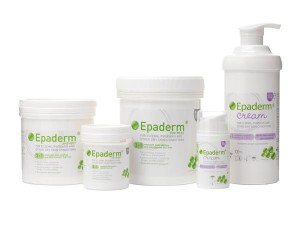Many people have naturally dry skin, and this can be made worse by cold weather, central heating at home and air conditioning at work. Dry skin is often rough and scaly, feels uncomfortable and tends to be itchy.
Coping with symptoms and triggers can sometimes seem a chore, yet with a few small tweaks to lifestyle factors that can lead to flare-ups, symptoms can be much improved.
One of the biggest triggers for many is temperature, especially during the winter which brings wind-chill, damp and cold. The key to overcoming potential weather triggers and maintaining healthy skin is a well-rounded skincare routine, which includes frequent and liberal use of moisturisers or emollients, such as Epaderm, even when the skin has improved as continual use will help prevent flare ups.
Loose fitting water proof clothes are also a must, as damp clothes can cling to skin, rubbing and irritating. Be sure to buy good quality winter clothes, such as gloves in scarfs, in a material that does not itch or chafe your skin. In this case, cotton or silk are both good choices.
Those who suffer with dry skin should avoid overly hot baths and showers, as the heat can dehydrate skin. Instead, opt for a warm but not hot bath, and use bath emollients to ensure that your skin is sufficiently hydrated after bathing.
Specific allergens such as dust mites, pollens, mould or animal fur in addition to dietary triggers and stress can also affect our skin and contribute to flare-ups. It is important to minimize exposure to these if they affect you. Keeping a diary of flare-up’s, symptoms and lifestyle actions could help spot correlations that cause your skin to react.
What are emollients?
Emollients are very effective moisturisers that soothe, smooth and hydrate the skin, keeping it moist and flexible so that it doesn’t itch as much.
Emollients play a vital role in relieving and improving the symptoms of eczema and other dry skin conditions. They come in a range of different formats (creams, lotions, ointments, skin cleansers and bath additives) and should be used generously and frequently to relieve the symptoms of dry skin and help provide a protective barrier.
Top tips
Emollients, like Epaderm Cream, cannot be over used – in fact, the more you use the better.
- Emollients should be applied generously and frequently to the affected area 2-3 times a day
- Apply directly to the skin in a downward motion in the direction of the hair growth. This will reduce the risk of blocking hair follicles
- Use emollients after bathing or showering
- Keep a small pot or pump handy at all times, and continue with emollient therapy even after the skin has improved to help prevent future flare ups
- Keep finger nails cut short
- Avoid biological detergents and fabric conditioners
The British Association of Dermatologists (BAD) recommends that for whole body application the following amounts of emollients should be used per week:
- Children under 10 years: 250g per week
- Children over 10 years and adults: 600g per week.
The Epaderm® Range
The Epaderm range was developed by dermatologists especially for people who suffer from dry skin conditions, such as eczema and psoriasis.



My hands get very dry and begin to crack. Will this help combat that? It can be very painful.
on January 20, 2015 at 2:28 pm CalebHi Caleb.
on January 23, 2015 at 4:16 pm KieranYes, Epaderm will help to combat dry and cracked skin on the hands. Apply Epaderm Ointment liberally to clean hands and put on a pair of tubifast gloves before going to bed. This will provide long-term moisturisation overnight and help reduce the dryness.
Kind Regards
Kieran
Hi Caleb,
It’s great to see so much positivity and sharing amongst sufferers! I’ve had eczema although a mild form since I was a kid, and couldn’t eat the same food
as siblings due to milk allergies, which were a symptom of my eczema.
Aloe vera Gel – This is my SAVIOUR as I have discovered recently!
on August 17, 2015 at 9:54 pm JessicaWill Epaderm help with Rosacea. My nose in particular get very red especially when the weather is hot, I stay out of the sun but it don’t help and people think I have sun burn
on August 10, 2015 at 11:15 am BelindaHi Belinda
on August 11, 2015 at 12:24 pm KieranThe Primary Care Dermatology Society (PCDS) state that emollients are considered generally helpful and soothing in the management of Rosacea.
However advice should be sought from your GP before proceeding as there are a number of different treatments available for Rosacea.
Kind Regards
Kieran